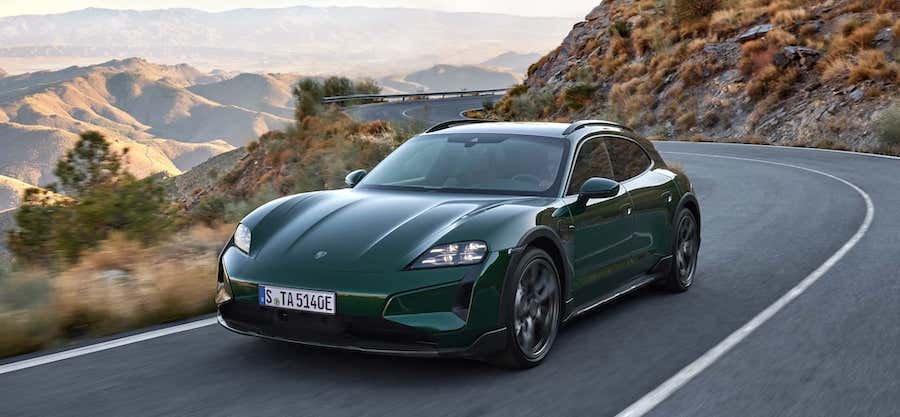New Porsche Taycan: 320kW charging, 422 miles and 939bhp

The Porsche Taycan has received an extensive upgrade as part of the firm's bid to cement its position as one of the fastest, longest-range and best-handling EVs on sale.
Due on sale in the spring, the new Taycan “excels over its predecessor in every discipline”, according to Porsche, which claims huge improvements in range, acceleration, charging speed, equipment and dynamics.
The electric car's revisions are aimed at building on the tremendous success of the model line, which has sold nearly 150,000 units since being launched in 2020.
A characteristically subtle refresh of the exterior – headlined by new creased front arches, revamped LED headlights and reshaped air vents – belies the extent of the substantial technical changes within.
While the similarly sized, combustion-powered Panamera dropped its estate body option as it moved into its third generation recently, the Taycan keeps all three variants: standard saloon, which makes up half of all Taycan sales in the UK, plus the bigger-booted Sport Turismo and jacked-up Cross Turismo.
Powertrains
The Taycan can be specified with a single rear motor from £86,500 or a choice of three twin-motor powertrains: 4S (£95,900), Turbo (£134,100) and Turbo S (£161,400).
The Turbo and Turbo S have been marked out more obviously as the performance-focused versions with exclusive colour schemes, unique wheels and liberal use of carbon trim.
The lowered, stiffened GTS is expected to reappear in the range in the coming months. All four launch variants bring a hefty power hike over their predecessors courtesy of a new motor on the rear axle that adds up to 107bhp and 30lb ft but weighs 10kg less than the previous unit.
The new motor houses a reworked rotor and stator, which boosts power density and cuts losses, while tweaks to the inverter software give “more efficient control” of the power delivery, says Porsche.
Meanwhile, a Formula E-derived ‘push to pass’ function, included in the Sport Chrono options pack, can add up to 94bhp for 10 seconds at a time.
The top-rung Taycan Turbo S, with a full 939bhp at its disposal in its most potent setting, can now sprint from 0-62mph in just 2.4sec – 0.4sec quicker than the pre-facelift car – which makes it one of the fastest-accelerating cars you can buy in the UK today.
The single-motor 429bhp Taycan, meanwhile, shaves 0.6sec off its sprint time to 4.8sec.
Range and charging
However, the bulk of the investment in this update has gone towards making the Taycan – which was already one of the longest-range and quickest-charging EVs on sale – more efficient.
As a result, it can now cover up to 35% more miles between charges, according to Porsche. The longest range – 422 miles on the WLTP combined cycle – is claimed by the rear-driven, single-motor Taycan equipped with the optional Performance Battery Plus, which at 105kWh is a chunky 12kWh bigger than before.
Comprising 396 individual pouch cells arranged into 33 modules, this new battery uses a different chemistry that boosts energy density and reduces internal resistance, which means the charging speed can be increased too.
As well as reclaiming its place among the UK’s longest-range electric cars, this means that the Taycan is once again officially the fastest-charging EV on sale, because it can now top up at speeds of 320kW – 50kW quicker than before – at suitable chargers.
In addition, the battery’s fast-charging window has been extended so that it can now accept speeds of more than 300kW for up to five minutes.
Porsche says it can get from 10-80% capacity in less than 18 minutes at an ambient temperature of 15deg C, compared with 37 minutes in the outgoing car.
Other range-boosting measures include revisions to the thermal management system, the wiring architecture and the regenerative braking function, which can now charge the battery at rates of up to 400kW under deceleration, compared with 290kW previously.
On four-wheel-drive models, the front motor now disconnects more often when not required to reduce power consumption at a cruise.
Dynamics
All Taycan variants now come as standard with adaptive two-chamber air suspension. Porsche says this sharpens the handling while providing a “broader bandwidth between comfort and performance”.
It has a self-levelling function to keep the body flat over uneven ground and it can also lower the car by up to 22mm at speed to reduce drag and improve stability.
Buyers can optionally upgrade to the Active Ride system, in which new two-valve shocks are connected to an electrohydraulic pump that can “build up forces between the body and wheels in a lightningfast, highly precise and targeted manner”.
Porsche says this set-up can “almost completely compensate” for imperfections and undulations in the Tarmac and can be configured to keep the car completely flat in hard corners and under acceleration. It can even be programmed so the car leans into bends, like a motorcycle.
Other important chassis upgrades include optimised brake pads, which reduce rolling resistance after braking and cool more efficiently, and a range of new wheels designed with aero efficiency in mind and wrapped in low-rolling-resistance tyres.
Interior
Upgrades to the cockpit centre on Porsche’s infotainment system, which features redesigned, clearer interfaces with additional functions.
But Porsche has also worked closely with Apple to enhance the capability and functionality of the Taycan’s CarPlay interface.
It can now be displayed on the instrument cluster, as well as the secondary touchscreen on the passenger side – which is coated with a special film to stop the driver being distracted – and can be used to control functions of the car itself, such as changing the radio station or adjusting the climate control, without leaving the phone mirroring interface.
Porsche has also extended the list of standard-fit equipment, including ambient lighting, park assist, wireless phone charger and a back-up camera on all cars.
Related News
